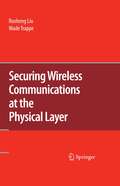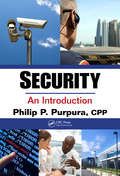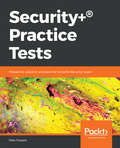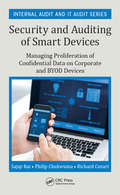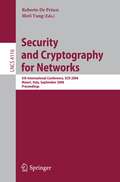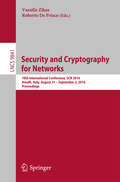- Table View
- List View
Securing VoIP: Keeping Your VoIP Network Safe
by Regis J. (Bud) BatesSecuring VoIP: Keeping Your VoIP Network Safe will show you how to take the initiative to prevent hackers from recording and exploiting your company’s secrets. Drawing upon years of practical experience and using numerous examples and case studies, technology guru Bud Bates discusses the business realities that necessitate VoIP system security and the threats to VoIP over both wire and wireless networks. He also provides essential guidance on how to conduct system security audits and how to integrate your existing IT security plan with your VoIP system and security plans, helping you prevent security breaches and eavesdropping.Explains the business case for securing VoIP SystemsPresents hands-on tools that show how to defend a VoIP network against attack.Provides detailed case studies and real world examples drawn from the authors’ consulting practice.Discusses the pros and cons of implementing VoIP and why it may not be right for everyone.Covers the security policies and procedures that need to be in place to keep VoIP communications safe.
Securing WebLogic Server 12c
by Luca Masini Rinaldi VincenzoThis book is written in simple, easy to understand format with lots of screenshots and step-by-step explanations. If you are a WebLogic Server administrator looking forward to a step by step guide to administer and configure WebLogic security, then this is the guide for you. Working knowledge of WebLogic is required.
Securing Windows Server 2008: Prevent Attacks from Outside and Inside Your Organization
by Aaron TiensivuMicrosoft hails the latest version of its flagship server operating system, Windows Server 2008, as "the most secure Windows Server ever". However, to fully achieve this lofty status, system administrators and security professionals must install, configure, monitor, log, and troubleshoot a dizzying array of new features and tools designed to keep the bad guys out and maintain the integrity of their network servers. This is no small task considering the market saturation of Windows Server and the rate at which it is attacked by malicious hackers. According to IDC, Windows Server runs 38% of all network servers. This market prominence also places Windows Server at the top of the SANS top 20 Security Attach Targets. The first five attack targets listed in the SANS top 20 for operating systems are related to Windows Server. This doesn't mean that Windows is inherently less secure than other operating systems; it's simply a numbers game. More machines running Windows Server. More targets for attackers to hack.As a result of being at the top of the "most used" and "most hacked" lists, Microsoft has released a truly powerful suite of security tools for system administrators to deploy with Windows Server 2008. This book is the comprehensive guide needed by system administrators and security professionals to master seemingly overwhelming arsenal of new security tools including: 1. Network Access Protection, which gives administrators the power to isolate computers that don't comply with established security policies. The ability to enforce security requirements is a powerful means of protecting the network.2. Enhanced solutions for intelligent rules and policies creation to increase control and protection over networking functions, allowing administrators to have a policy-driven network.3. Protection of data to ensure it can only be accessed by users with the correct security context, and to make it available when hardware failures occur.4. Protection against malicious software with User Account Control with a new authentication architecture.5. Increased control over your user settings with Expanded Group Policy....to name just a handful of the new security features. In short, Windows Server 2008 contains by far the most powerful and complex suite of security tools ever released in a Microsoft Server product. Securing Windows Server 2008 provides system administrators and security professionals with the knowledge they need to harness this power.* Describes new technologies and features in Windows Server 2008, such as improvements to networking and remote access features, centralized server role management, and an improved file system. * Outlines steps for installing only the necessary components and subsystems of Windows Server 2008 in your environment. No GUI needed.* Describes Windows Server 2008?s security innovations, such as Network Access Protection, Federated Rights Management, and Read-Only Domain Controller* Includes coverage of monitoring, securing, and troubleshooting Windows Server 2008* Covers Microsoft's Hyper-V virtualization technology, which is offered as an add-on to four of the eight versions of Windows Server 2008 and as a stand-alone product
Security: An Introduction
by Philip P. PurpuraToday, threats to the security of an organization can come from a variety of sources- from outside espionage to disgruntled employees and internet risks to utility failure. Reflecting the diverse and specialized nature of the security industry, Security: An Introduction provides an up-to-date treatment of a topic that has become increasingly comple
Security: An Introduction
by Philip P. PurpuraToday, threats to the security of an organization can come from a variety of sources- from outside espionage to disgruntled employees and internet risks to utility failure. Reflecting the diverse and specialized nature of the security industry, Security: An Introduction provides an up-to-date treatment of a topic that has become increasingly comple
Security+® Practice Tests: Prepare For, Practice, And Pass The Comptia Security+ Exam
by Mike ChapplePrepare for, practice, and pass the CompTIA Security+ exam
Security Analytics: A Data Centric Approach to Information Security (Chapman & Hall/CRC Cyber-Physical Systems)
by Mehak Khurana Shilpa MahajanThe book gives a comprehensive overview of security issues in cyber physical systems by examining and analyzing the vulnerabilities. It also brings current understanding of common web vulnerabilities and its analysis while maintaining awareness and knowledge of contemporary standards, practices, procedures and methods of Open Web Application Security Project. This book is a medium to funnel creative energy and develop new skills of hacking and analysis of security and expedites the learning of the basics of investigating crimes, including intrusion from the outside and damaging practices from the inside, how criminals apply across devices, networks, and the internet at large and analysis of security data. Features Helps to develop an understanding of how to acquire, prepare, visualize security data. Unfolds the unventured sides of the cyber security analytics and helps spread awareness of the new technological boons. Focuses on the analysis of latest development, challenges, ways for detection and mitigation of attacks, advanced technologies, and methodologies in this area. Designs analytical models to help detect malicious behaviour. The book provides a complete view of data analytics to the readers which include cyber security issues, analysis, threats, vulnerabilities, novel ideas, analysis of latest techniques and technology, mitigation of threats and attacks along with demonstration of practical applications, and is suitable for a wide-ranging audience from graduates to professionals/practitioners and researchers.
Security Analytics: A Data Centric Approach to Information Security (Chapman & Hall/CRC Cyber-Physical Systems)
by Mehak Khurana Shilpa MahajanThe book gives a comprehensive overview of security issues in cyber physical systems by examining and analyzing the vulnerabilities. It also brings current understanding of common web vulnerabilities and its analysis while maintaining awareness and knowledge of contemporary standards, practices, procedures and methods of Open Web Application Security Project. This book is a medium to funnel creative energy and develop new skills of hacking and analysis of security and expedites the learning of the basics of investigating crimes, including intrusion from the outside and damaging practices from the inside, how criminals apply across devices, networks, and the internet at large and analysis of security data. Features Helps to develop an understanding of how to acquire, prepare, visualize security data. Unfolds the unventured sides of the cyber security analytics and helps spread awareness of the new technological boons. Focuses on the analysis of latest development, challenges, ways for detection and mitigation of attacks, advanced technologies, and methodologies in this area. Designs analytical models to help detect malicious behaviour. The book provides a complete view of data analytics to the readers which include cyber security issues, analysis, threats, vulnerabilities, novel ideas, analysis of latest techniques and technology, mitigation of threats and attacks along with demonstration of practical applications, and is suitable for a wide-ranging audience from graduates to professionals/practitioners and researchers.
Security Analytics for the Internet of Everything
by Mohiuddin Ahmed Abu S. S. M. Barkat Ullah Al-Sakib Khan PathanSecurity Analytics for the Internet of Everything compiles the latest trends, technologies, and applications in this emerging field. It includes chapters covering emerging security trends, cyber governance, artificial intelligence in cybersecurity, and cyber challenges. Contributions from leading international experts are included. The target audience for the book is graduate students, professionals, and researchers working in the fields of cybersecurity, computer networks, communications, and the Internet of Everything (IoE). The book also includes some chapters written in a tutorial style so that general readers can easily grasp some of the ideas.
Security Analytics for the Internet of Everything
by Mohiuddin Mohiuddin Ahmed Abu Abu Barkat Al-Sakib Khan PathanSecurity Analytics for the Internet of Everything compiles the latest trends, technologies, and applications in this emerging field. It includes chapters covering emerging security trends, cyber governance, artificial intelligence in cybersecurity, and cyber challenges. Contributions from leading international experts are included. The target audience for the book is graduate students, professionals, and researchers working in the fields of cybersecurity, computer networks, communications, and the Internet of Everything (IoE). The book also includes some chapters written in a tutorial style so that general readers can easily grasp some of the ideas.
Security and Artificial Intelligence: A Crossdisciplinary Approach (Lecture Notes in Computer Science #13049)
by Lejla Batina Thomas Bäck Ileana Buhan Stjepan PicekAI has become an emerging technology to assess security and privacy, with many challenges and potential solutions at the algorithm, architecture, and implementation levels. So far, research on AI and security has looked at subproblems in isolation but future solutions will require sharing of experience and best practice in these domains.The editors of this State-of-the-Art Survey invited a cross-disciplinary team of researchers to a Lorentz workshop in 2019 to improve collaboration in these areas. Some contributions were initiated at the event, others were developed since through further invitations, editing, and cross-reviewing. This contributed book contains 14 invited chapters that address side-channel attacks and fault injection, cryptographic primitives, adversarial machine learning, and intrusion detection. The chapters were evaluated based on their significance, technical quality, and relevance to the topics of security and AI, and each submission was reviewed in single-blind mode and revised.
Security and Auditing of Smart Devices: Managing Proliferation of Confidential Data on Corporate and BYOD Devices (Security, Audit and Leadership Series)
by Sajay Rai Philip Chukwuma Richard CozartMost organizations have been caught off-guard with the proliferation of smart devices. The IT organization was comfortable supporting the Blackberry due to its ease of implementation and maintenance. But the use of Android and iOS smart devices have created a maintenance nightmare not only for the IT organization but for the IT auditors as well. This book will serve as a guide to IT and Audit professionals on how to manage, secure and audit smart device. It provides guidance on the handling of corporate devices and the Bring Your Own Devices (BYOD) smart devices.
Security and Auditing of Smart Devices: Managing Proliferation of Confidential Data on Corporate and BYOD Devices (Security, Audit and Leadership Series)
by Sajay Rai Philip Chukwuma Richard CozartMost organizations have been caught off-guard with the proliferation of smart devices. The IT organization was comfortable supporting the Blackberry due to its ease of implementation and maintenance. But the use of Android and iOS smart devices have created a maintenance nightmare not only for the IT organization but for the IT auditors as well. This book will serve as a guide to IT and Audit professionals on how to manage, secure and audit smart device. It provides guidance on the handling of corporate devices and the Bring Your Own Devices (BYOD) smart devices.
Security and Cryptography for Networks: 9th International Conference, SCN 2014, Amalfi, Italy, September 3-5, 2014. Proceedings (Lecture Notes in Computer Science #8642)
by Michel Abdalla Roberto De PriscoThis book constitutes the proceedings of the 9th International Conference on Security and Cryptography, SCN 2014, held in Amalfi, Italy, in September 2014. The 31 papers presented in this volume were carefully reviewed and selected from 95 submissions. They are organized in topical sections on key exchange; multilinear maps and obfuscation; pseudorandom function extensions; secure computation - foundations and algorithms; network security; functional encryption; cryptanalysis; secure computation - implementation; zero knowledge; message authentication; proofs of space and erasure; public-key encryption.
Security and Cryptography for Networks: 11th International Conference, SCN 2018, Amalfi, Italy, September 5–7, 2018, Proceedings (Lecture Notes in Computer Science #11035)
by Dario Catalano Roberto De PriscoThis book constitutes the proceedings of the 11th International Conference on Security and Cryptography for Networks, SCN 2018, held in Amalfi, Italy, in September 2018.The 30 papers presented in this volume were carefully reviewed and selected from 66 submissions. They are organized in topical sections on signatures and watermarking; composability; encryption; multiparty computation; anonymity and zero knowledge; secret sharing and oblivious transfer; lattices and post quantum cryptography; obfuscation; two-party computation; and protocols.
Security and Cryptography for Networks: 13th International Conference, SCN 2022, Amalfi (SA), Italy, September 12–14, 2022, Proceedings (Lecture Notes in Computer Science #13409)
by Clemente Galdi Stanislaw JareckiThis book constitutes the proceedings of the 13th International Conference on Security and Cryptography for Networks, SCN 2022, held in Amalfi, Italy, in September 2022. The 33 full papers presented in this volume were carefully reviewed and selected from 101 submissions. They are organized in topical sections: Ciphers, Cryptanalysis, Defenses; Public Key Encryption; Authentication and Signatures, Multiparty Computation; Zero-Knowledge Proofs and Applications.
Security and Cryptography for Networks: 12th International Conference, SCN 2020, Amalfi, Italy, September 14–16, 2020, Proceedings (Lecture Notes in Computer Science #12238)
by Clemente Galdi Vladimir KolesnikovThis book constitutes the proceedings of the 12th International Conference on Security and Cryptography for Networks, SCN 2020, held in Amalfi, Italy, in September 2020*.The 33 papers presented in this volume were carefully reviewed and selected from 87 submissions. They are organized in topical sections on blockchain; multiparty computation; oblivious RAM; primitives and constructions; signatures, encryption, and algebraic constructions; symmetric crypto; theory and lower bounds ; zero-knowledge. *The conference was held virtually due to the COVID-19 pandemic.
Security and Cryptography for Networks: 7th International Conference, SCN 2010, Amalfi, Italy, September 13-15, 2010, Proceedings (Lecture Notes in Computer Science #6280)
by Juan A. Garay Roberto De PriscoSecurity and Cryptography for Networks: 6th International Conference, SCN 2008, Amalfi, Italy, September 10-12, 2008, Proceedings (Lecture Notes in Computer Science #5229)
by Rafail Ostrovsky Roberto De Prisco Ivan ViscontiThis book constitutes the refereed proceedings of the 6th International Conference on Security and Cryptology for Networks, SCN 2008, held in Amalfi, Italy, in September 2008. The book contains one invited talk and 26 revised full papers which were carefully reviewed and selected from 71 submissions. The papers are organized in topical sections on Implementations, Protocols, Encryption, Primitives, Signatures, Hardware and Cryptanalysis, and Key Exchange.
Security and Cryptography for Networks: 5th International Conference, SCN 2006, Maiori, Italy, September 6-8, 2006, Proceedings (Lecture Notes in Computer Science #4116)
by Roberto De Prisco Moti YungHere are the refereed proceedings of the 5th International Conference on Security and Cryptology for Networks, SCN 2006. The book offers 24 revised full papers presented together with the abstract of an invited talk. The papers are organized in topical sections on distributed systems security, signature schemes variants, block cipher analysis, anonymity and e-commerce, public key encryption and key exchange, secret sharing, symmetric key cryptanalisis and randomness, applied authentication, and more.
Security and Cryptography for Networks: 8th International Conference, SCN 2012, Amalfi, Italy, September 5-7, 2012, Proceedings (Lecture Notes in Computer Science #7485)
by Ivan Visconti Roberto De PriscoThis book constitutes the proceedings of the 8th International Conference on Security and Cryptography, SCN 2012, held in Amalfi, Italy, in September 2012. The 31 papers presented in this volume were carefully reviewed and selected from 72 submissions. They are organized in topical sections on cryptography from lattices; signature schemes; encryption schemes; efficient two-party and multi-party computation; security in the UC framework; cryptanalysis; efficient constructions; and protocols and combiners.
Security and Cryptography for Networks: 10th International Conference, SCN 2016, Amalfi, Italy, August 31 – September 2, 2016, Proceedings (Lecture Notes in Computer Science #9841)
by Vassilis Zikas Roberto De PriscoThis book constitutes the proceedings of the 10th International Conference on Security and Cryptography, SCN 2016, held in Amalfi, Italy, in August/September 2016. The 30 papers presented in this volume were carefully reviewed and selected from 67 submissions. They are organized in topical sections on encryption; memory protection; multi-party computation; zero-knowledge proofs; efficient protocols; outsourcing computation; digital signatures; cryptanalysis; two-party computation; secret sharing; and obfuscation.
Security and Data Reliability in Cooperative Wireless Networks
by Emad HassanFollowing a detailed overview of cooperative communications and the physical layer security, this book proposes relay and jammer selection schemes for security in one-way cooperative networks and to improve physical layer security in two-way cooperative networks. It also proposes a Cooperative Hybrid Self-Healing scheme to enhance the confidentiality of the data collected by UWSN. It ends with a proposal called Self-Healing Cluster Controlled Mobility (SH-CCM) scheme based on hybrid cooperation between both Proactive and Reactive peers and the sick sensors at both network and cluster levels to guarantee the security in UWSN.
Security and Data Reliability in Cooperative Wireless Networks
by Emad HassanFollowing a detailed overview of cooperative communications and the physical layer security, this book proposes relay and jammer selection schemes for security in one-way cooperative networks and to improve physical layer security in two-way cooperative networks. It also proposes a Cooperative Hybrid Self-Healing scheme to enhance the confidentiality of the data collected by UWSN. It ends with a proposal called Self-Healing Cluster Controlled Mobility (SH-CCM) scheme based on hybrid cooperation between both Proactive and Reactive peers and the sick sensors at both network and cluster levels to guarantee the security in UWSN.



